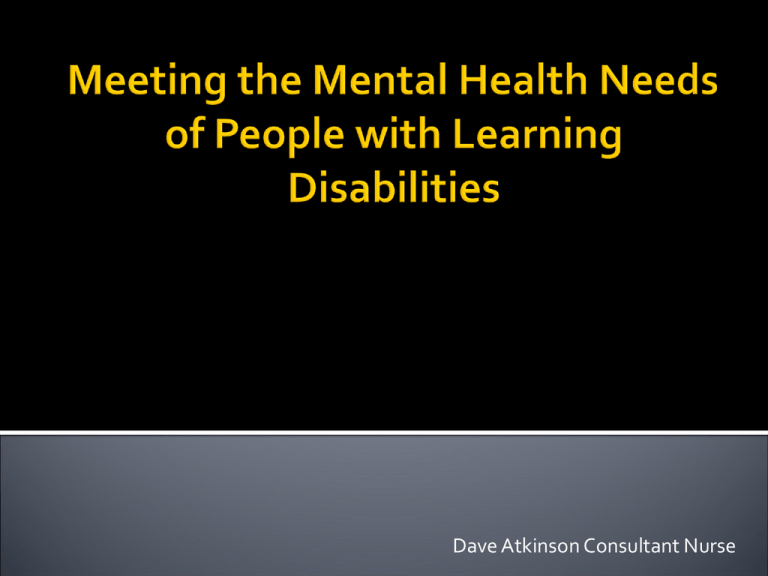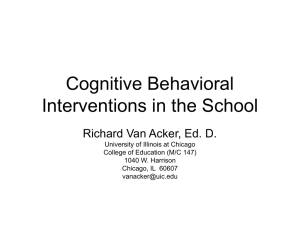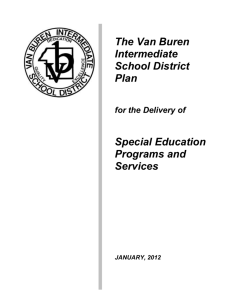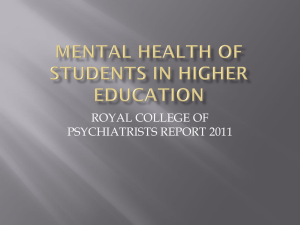Meeting the Mental Health Needs of People with Learning Disabilities
advertisement

Dave Atkinson Consultant Nurse 'in short, herein lies the difference between retarded persons and madmen: madmen put the wrong ideas together and so make erroneous propositions, but argue and reason rightly from them: but retarded persons make few or no propositions and scarcely argue at all‘ Locke 18th Century cited in Szymanski, 1994 In some ways nothing much: Subjective experiences... Normal reactions to life’s stresses... But: Increased prevalence of disorders Atypical presentations complicate assessment / diagnosis Complex co-morbidities Treatment may be more complex Mental Health - successful performance of mental functions, resulting in productive activities, fulfilling relationships... and the ability to adapt to change and cope with adversity. Mental health needs are needs that must be met in order to avoid / alleviate mental disorders Mental Disorders - health conditions characterized by alterations in thinking, mood, and/or behaviour associated with distress and/or impaired functioning. 800,000 adults with LD in England – 180,000 known to services – where are the others?? 25-40% prevalence of mental health problems amongst adults – cf 16% general popn. 36% prevalence of mental health problems amongst children and young people (cf 8% general popn) Young people with MH problems are 33x more likely to be on the Autistic spectrum 3x prevalence schizophrenia Major mood disorders 6.6% cf 2% general popn. OCD 3.5% cf 1% general popn. ADHD - 12% of adults with mild LD reported to have cf 4% general popn. Dementia 21.6% cf 5.7% post 65yrs (higher in DS). Generalised Anxiety Disorder reported at around 3.8% similar to general popn. Eating disorders: anorexia and bulimia very rare (why??). But pica, binge eating disorder etc... Biological Psychological Social Brain damage Self insight Increased exposure to adverse life events Sensory impairments Poor self image Lower socio economic groups Physical health problems / chronic pain Poor coping mechanisms Discrimination / abuse Genetic conditions Bereavement & loss Reduced social networks Medication side effects History and expectation of failure - learned helplessness Transitions Sovner’s (1986) Confounding Variables: Intellectual distortion – the difficulty an individual has in communicating their internal feelings due to decreased intellect and impaired language ability. Psychosocial masking –impoverished social skills and life experiences lead to psychiatric symptoms less rich in content, compared to a non disabled person. Cognitive Disintegration – the lowered threshold for anxiety to become overwhelming thereby disorganising cognitive function further. E.g. transient breaks in reality testing. Baseline exaggeration – the increase in disturbed behaviours that may occur as a result of superimposition of a mental disorder. The increase in baseline symptoms is ascribed to a fluctuation s a result of learning disability. Diagnostic Overshadowing (Reiss 1982, 83) The presence of a learning disability reduces the diagnostic significance of an accompanying behaviour problem – easier to call it CB Reiss et al. (1982). Case description of debilitating fear presented to 2 groups of psychologists. Group 1 told IQ was 60, Group 2 told IQ was 102. Both groups asked to diagnose and recommend interventions. Individual with learning disability less likely to be diagnosed with phobia and have treatment recommended. The presence of the LD overshadowed the presence of behaviour indicative of psychopathology. (Similar subsequent findings for SCZ and PD). Reliance upon carers – training, nature of relationship and previous labels may colour attitude and affect the validity / reliability of information. Classification issues related to both ICD 10 and DSM IV for this client group. Acquiescence Reduced attention span affecting MSE’s Negative experiences of interviews may colour performance within MSE Developmental issues – cognitive, moral, ego defence mechanisms Physical Co morbidity Classic Study (Ryan & Sunada 1997) ▪ 1135 subjects with LD referred for mental health assessment over a 6 year period ▪ All were previously presumed to be medically well ▪ All were meticulously medically evaluated ▪ Screening assessment for all ▪ Expanded assessment based on clinical status Results ▪ 75% suffered 1 or more medical problem, almost all previously undiagnosed or undertreated ▪ Most commonly discovered conditions: ▪ ▪ ▪ ▪ ▪ ▪ ▪ ▪ ▪ Epilepsy Hypothyroidism Tourette’s GI reflux Chronic pain Arthritis Anaemia Stroke Etc… - 46% - 13% - 12% - 10% -9% - 5% - 3% - 3% Social Interventions & Relapse prevention: Having one’s various needs recognised and met Improving physical health Feeling secure and safe from harm Being given choice and control over one’s life Developing assertiveness and communication skills Having employment and meaningful daytime activities Having responsibility – recognising achievements Being supported in a person centred way Psychological Therapies Need to be modified in light of communication and cognitive profile Evidence / expert opinion supports use of: ▪ ▪ ▪ ▪ ▪ Psychodynamic psychotherapy Systemic therapy Counselling Behavioural Interventions CBT Psychotropic Medication Issues: Full range of medications used. Efficacy unclear - LD popn. usually excluded from clinical trials Positive responses to ‘atypical antispsychotics’ at a low anxiolytic dosage Higher prevalence of side effects ▪ ▪ ▪ ▪ ▪ Adverse effects at lower dosages Higher proportion of atypical responses Adverse effects can occur following lower dosages given for briefer periods Lack of subjective reporting makes side effects difficult to spot Akathisia – the most overlooked side effect in LD – often taken to be CB Polypharmacy often inevitable due to medication to treat physical morbidity Often prescribed for CB outside of ICD diagnosis… Consent / best interests dilemmas Governance: Research Information User experience Audit Risk Education & cpd Workforce issues Observation & screening tools Listen to your service users Use terms appropriately (No lay terms!!) Understand how symptoms and signs may be distorted in the LD popn. Facilitate access to specialists Help specialists make sense of LD Holistic formulation Care Coordination Deliver interventions Develop support workers









